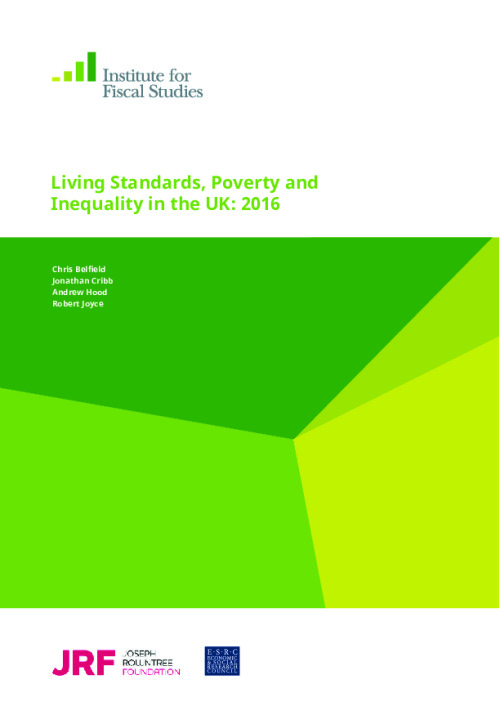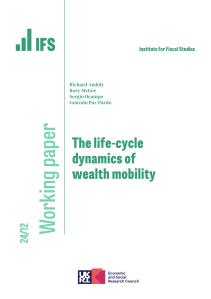The focus of this report is the distribution of household income in the UK. We assess the changes to average incomes, income inequality and poverty that occurred in the latest year of data (2014–15), and put these in historical context using comparable data spanning the last 50 years.
The analysis draws upon the data underlying the latest figures from the Department for Work and Pensions (DWP)’s Households Below Average Income (HBAI) series, published on 28 June 2016. The HBAI series is derived from the Family Resources Survey (FRS), a survey of more than 20,000 households in the UK that asks detailed questions about income from a range of sources.
Recent years have seen a truly remarkable transformation in patterns of low income in the UK. One great success is that pensioner incomes have grown so much and, after housing costs, they are now the least likely major demographic group to be in income poverty. Another is that more people are in work than ever before. The proportion of children living in a household where no-one works has fallen from nearly one in four in 1994–95 to less than one in six in 2014–15. The “new poor” tend to live in households where there is someone in work. Only a third of children below the government’s absolute poverty line now live in a workless household – two thirds of those classified as poor are poor despite the fact that at least one of their parents is in work. So if the new Prime Minister takes forward the ‘life chances’ strategy started by her predecessor, that strategy needs to focus on lifting the incomes of working households.
Our analysis of the latest HBAI data begins in Chapter 2 with a look at average living standards and how they have changed over time. Chapter 3 analyses how changes in incomes have differed across the income distribution, focusing in particular on the factors affecting inequality during the recent recovery in living standards. Chapter 4 examines in more detail how income inequality in childhood has changed over the last 20 years. Finally, Chapter 5 analyses changes in income poverty and in measures of deprivation that are not based on income. It also examines the role falling worklessness has played in reducing child poverty and discusses the relationship between incomes and measures of financial difficulties.
Key findings
- The incomes of poor households are increasingly sensitive to what happens in the labour market. Income from employment made up half of income for the poorest fifth of households in 2014–15 (excluding pensioners), up from less than a third 20 years ago. While this is good news it does mean that the poorest are now more vulnerable to any downturn in the labour market than they would have been in the past.
- Further falls in worklessness have much less scope to reduce child poverty than in the past. The falls in worklessness that we’ve already seen, plus the fact that rates of poverty rates among working families have risen, mean that only one third of children in income poverty now live in workless households.
- Median income overall has finally moved 2% above pre-crisis (2007–08) levels, but for adults aged 31 to 59 it is at its pre-crisis level and for those aged 22 to 30 it is still 7% lower. It is highly unusual to see no growth in working-age incomes over a seven-year period.
- Inequality in workers’ weekly earnings has fallen during the recovery. This was the result of a recovery in the number of hours worked by those with low hourly wages. Between 2011–12 and 2014–15, real weekly earnings grew by 4.4% at the 10th percentile, but fell by 1.2% at the 90th percentile.
- Strong employment growth and weak earnings growth have combined to hold down inequality in recent years. Since 2011–12, falls in household worklessness and increases in the number of second earners both mainly boosted the incomes of poorer households. Meanwhile weak pay growth has held back the incomes of higher income households.
- In key respects middle income families with children now more closely resemble poor families than in the past. Half are now renters rather than owner occupiers and, while poorer families have become less reliant on benefits as employment has risen, middle- income households with children now get 30% of their income from benefits and tax credits, up from 22% 20 years ago.
- Mothers’ earnings are increasingly important for households with children. For middle-income children the fraction of household income coming from women’s earnings rose from less than a fifth in 1994–95 to more than a quarter in 2014–15; and it doubled from 7% to 15% for the poorest fifth.
Presentations
- Chris Belfield, Living standards
- Andrew Hood, Income inequality
- Jonathan Cribb, Income inequality in childhood
- Robert Joyce, Poverty
Click here to access data on living standards, poverty and inequality since 1961 and to view our other annual reports on the topic.











